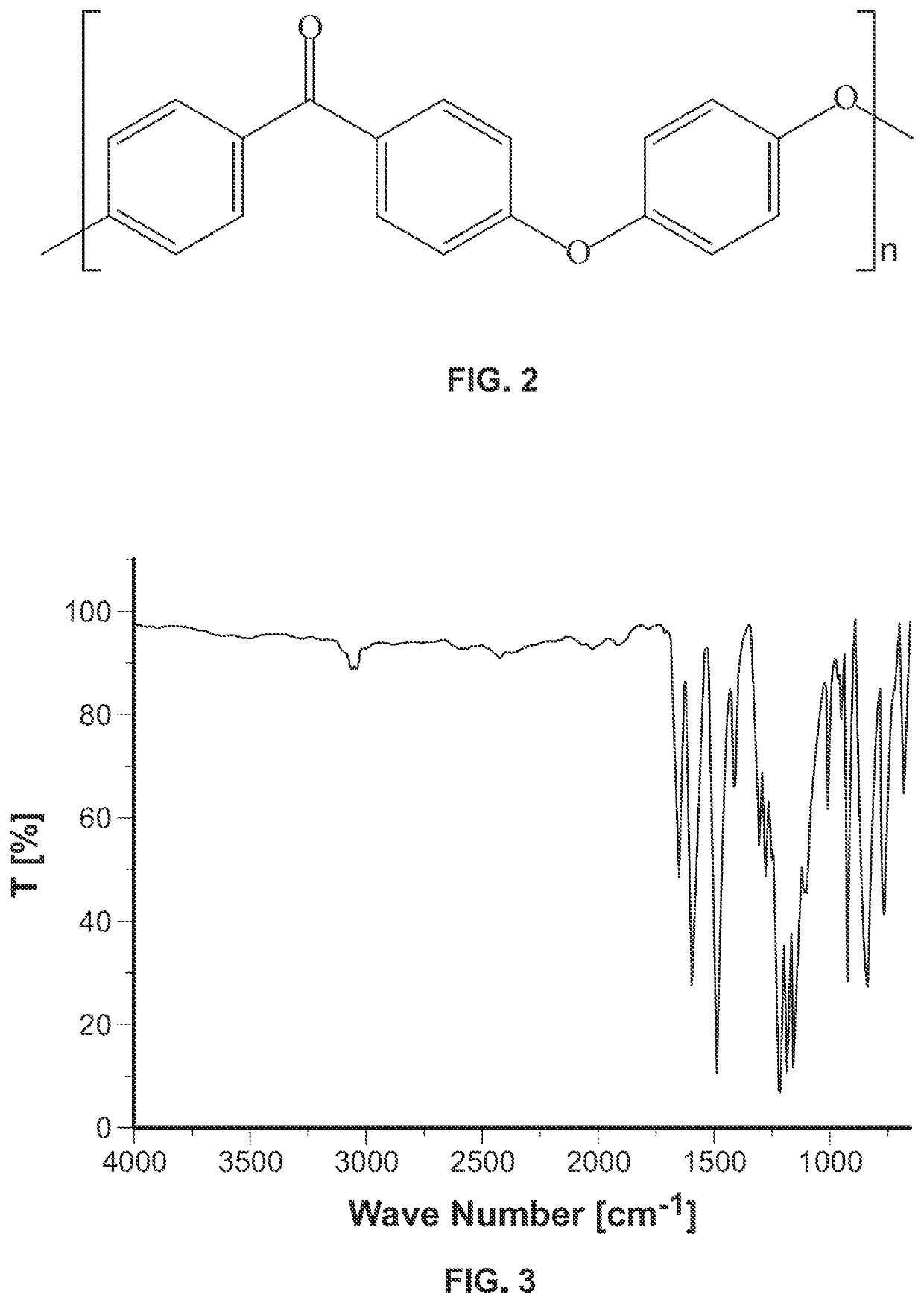Material for bone implants and method of producing same
a bone implant and material technology, applied in the field of bone implant material, can solve the problems of difficult to predict the functionality of the implant material, the inability to phagocytize the material, and the difficulty of meeting all requirements with one material
- Summary
- Abstract
- Description
- Claims
- Application Information
AI Technical Summary
Benefits of technology
Problems solved by technology
Method used
Image
Examples
example 1
Analysis of Unmodified PEEK Material
[0101]The purchased material was PEEK optima by Invibio, Hofheim. These sheets had an amorphous structure and therefore appeared transparent with a white-beige color. An ATR-IR spectrum of the unmodified material can be seen in FIG. 3 and shows a spectrum that matches well with literature results. Typical bands for aromatic polymers such as PEEK are the aromatic stretching vibrations at 1650 cm−1, 1593 cm−1, and 1486−1, as well as the diaryl ether stretching vibration at 1216 cm−1. As PEEK has a relatively strong autofluorescence, it was not possible to carry out a complementary Raman study.
[0102]Furthermore, the surface was examined with X-ray photoelectron spectroscopy (XPS). An overview spectrum is shown in FIG. 4, and the results are summarized in Table 1. Since PEEK is a non-conductive material, there was charging phenomena during the measurement, which resulted in charge equilibrium and a concomitant shift of the signals by a few electron vo...
example 2
Wet-Chemical Modifications of PEEK—Reduction to PEEK-OH
[0106]In order to increase the biocompatibility of the material, the surface needs to be activated at first in order to chemically bond biopolymers, such as gelatin, afterward.
[0107]In the case of the PEEK material, the keto group was at first reduced to a hydroxyl group to serve as an anchor point between the gelatin layer and the material for the subsequent coupling reactions. This was done according to a modification known in the prior art. To this end, a PEEK sheet was immersed in a solution of sodium borohydride in dimethylsulphoxide. The resulting product PEEK-OH will be mentioned hereinafter.
[0108]To verify the success of the reaction, NMR spectroscopy has been used (FIG. 9). Since the unmodified material only has aromatic protons, the appearance of non-aromatic protons in a 1H-NMR experiment to should correlate directly with the hydroxyl modification and thus the success of the reaction.
[0109]Also, the aliphatic protons ...
example 3
Coupling of Linker Molecules—PEEK-COOH
[0115]In order to ensure covalent binding of the gelatin molecules to the PEEK-OH surface, it has to be modified chemically with appropriate linker molecules. The reactions specified below are possible here. In the case of metal oxide surfaces, silanes would be used as linker molecules.
[0116]In order to create a surface with acid groups, a linker molecule was bound to the surface via an ester bond. This should be a dicarboxylic acid, which is interconnected by methylene groups of a variable number. Exemplarily, the reaction was carried out on a succinic acid linker.
[0117]This was realized with the help of N,N′-dicyclohexylcarbodiimide (DCC) and 4-dimethylaminopyridine (DMAP). Typically, during the reaction procedure, two equivalents of succinic acid were initially dissolved in tetrahydrofuran (THF) and cooled with an ice bath. Then one equivalent of DCC and 0.1 equivalent of DMAP were added to the cooled solution. After four hours, the PEEK-OH s...
PUM
| Property | Measurement | Unit |
|---|---|---|
| Fraction | aaaaa | aaaaa |
| Fraction | aaaaa | aaaaa |
| Fraction | aaaaa | aaaaa |
Abstract
Description
Claims
Application Information
 Login to View More
Login to View More - R&D
- Intellectual Property
- Life Sciences
- Materials
- Tech Scout
- Unparalleled Data Quality
- Higher Quality Content
- 60% Fewer Hallucinations
Browse by: Latest US Patents, China's latest patents, Technical Efficacy Thesaurus, Application Domain, Technology Topic, Popular Technical Reports.
© 2025 PatSnap. All rights reserved.Legal|Privacy policy|Modern Slavery Act Transparency Statement|Sitemap|About US| Contact US: help@patsnap.com



